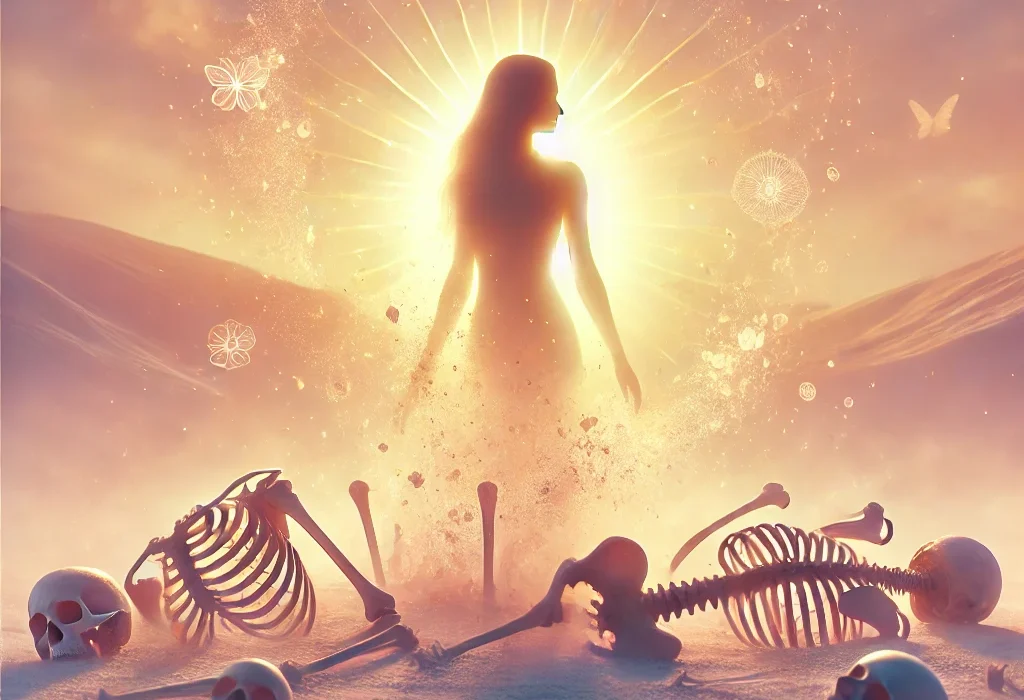
The Bone Collector
THE BONE COLLECTOR
There’s an old woman—a wild woman, I hear, who hides in a place that everyone knows about, but few have ever seen. She’s hairy and fat and makes more animal sounds than human. She crows and cackles and wails over would-be storytellers, begging them to come and sing along with her, for storytellers are the only company she allows into her cave. Folks say she lives in the Texas Hill Country among the limestone slopes of the Llano Uplift. But others believe she’s buried near an abandoned well outside Tucson, Arizona. A man said once he’d seen her traveling south in a burnt out car with the back window shot out. Then a woman said, no, she’d seen her standing alongside the highway just outside El Paso waiting to ride shotgun in the big trucks crossing the desert headed to California. Another woman claimed she’d seen her once, standing outside her door in the ghetto, taking notes.
She’s a wild woman all right, but I call her The Bone Collector. For you see, her passion is to wander from here to there, collecting the bones of unfinished and never-told stories, scattered remnants in danger of being lost to the world. She fills her cave with such bones, bones both good and bad, of half-done lives, of unfinished business, of relationships torn asunder, of unrecognized Thin Places,of non-existent self-confidence, point of view problems, of a strong sense of place.
She creeps and crawls and sifts through the dry riverbeds, across mesas, through forests, and mountaintops, and across fields of wildflowers looking for such bones.
When she has assembled an entire skeleton, when she has the last bone in place and the beautiful bone white creature is laid out before her, she sits by the fire and thinks about what song she will sing.
After she decides—after she is sure, she stands over the creature, raises her arms over it and sings out. And while she sings, the bones slowly move and begin to come together. The rib bones and leg bones of the creature begin to flesh out and it becomes covered in fur. She sings longer and the creature comes into being; its tail curls upward, shaggy and strong. The more the bone collector sings, the more the creature begins to breathe.
Still she sings. She sings until the floor of the hill country shakes. And as she sings, the creature opens its eyes, leaps up, and runs down through the canyon. Somewhere, whether by the speed of it’s running or by splashing its way into the river, or by a ray of sunlight, or moonlight hitting it just right, the creature suddenly transforms into a mature, joy-filled woman, content with herself, and a voice free to express who she is, what she stands for, and what she absolutely will not stand for. Content at last, she runs free toward the horizon. So it is said that if you wander the Texas Hill Country near sundown, and you are perhaps a little lost, and certainly tired, that you are lucky, for this wild woman—this bone collector, may take a liking to you and show you something—something of the soul.
Our stories start as a bundle of bones collected from the wilds. It is our work to recover the parts. It is a painstaking process best done when the shadows are just right, for it takes much looking. The singing bone collector shows us what to look for—that indestructible life force—the bones—the foundation of our tales. She promises if we sing the songs and call up that life force within us, our stories will take shape. This singing bone collector who lives inside the desert of each of us crisscrosses all nations down through the centuries. To sing—to write the story within us—we must sing over the bones that we collect. We must descend into that wild part of ourselves—of great feeling—emotion—to capture and create that song. Her whiskers sense the future, knows the past as well as the present. She has the far-seeing eye of the old crone. She lives backward and forward in time simultaneously, correcting for one side by dancing with the other.
The old Wild Woman of Pay It Forward, lives within each of us, leaving us the moral obligation—and the delight—to live and write what we perceive, and when we do, to pay it forward –to share what we’ve learned with others coming along behind. Our work is to show we have been breathed upon—to show it in our stories, Within each of us is the old woman who collects bones. The soul-bones, as it were, for story.
Bones with the potential to be fleshed out, bones to change ourselves, and then change our world. The writer must have freedom to move, to speak, to be angry, and to create.
Today, that singing wild woman inside of you collects bones. She is the soul self, the builder of story. She makes and remakes story. What story is she making in you?
Climb up into the cave. Crawl through the doorway or window of a dream. Sift through the sand and see what you find.
Go gather bones.
(Inspired by a story in The Women Who Run With Wolves, written by Clarissa Pinkola Estes, Ph.D.)







